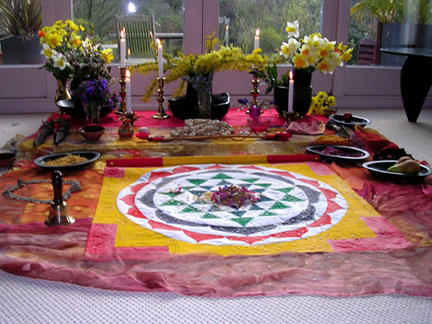Tantric ritual procedures – I
For this occasional series, I’m going to provide some short notes on various tantric ritual procedures. Tantric rituals tend to follow a fixed sequence of actions (pūjā-vidhi) as set forth in the ritual manuals (paddhati) – often distillations of much longer tantric scriptures, giving step-by-step guides for practitioners.
For example, in the Śaiva Siddhanta tradition, the daily worship of Śiva – nityapūjā – consisted of three phases. Firstly, the devotee had to ritually purify themselves, the place where the ritual was taking place, the mantras, and the liṅga into which Śiva would be invoked. Then the devotee would ritually invoke Śiva into a stone liṅga, and finally, the devotee would offer a series of services to Śiva, treating him as an honoured guest, as an expression of his homage to the Lord. This daily worship is said to lead to both liberation and worldly enjoyment. According to the Siddhanta doctrine, daily worship also prevents the build-up of fetters which would otherwise accrue from the karma brought about by action. Each of these broad phases is composed of numerous sub-stages. For example, there are at least 18 subsidiary rites for the full preparation of a stone liṅga to receive the presence of Śiva. Daily worship also included Sūryapūjā – a daily ritual addressed to the Sun as a form of Śiva.
Dhyāna
Many tantric rituals begin with a dhyāna-śloka, a verse (or set of verses) that sets out the image of the deity to be worshipped. These verses tend to follow the iconographical representations of the chosen deity (iṣṭadevatā). Dhyāna-ślokas give a succinct description of the deity for meditation and contemplation. They convey not only the iconographical appearance of the deity but also the dominant mood or sentiment associated with them, which the practitioner emulates or cultivates in themselves. Here is an example of a Kālī dhyāna translated by Mike Magee:
“The Kulakaulika, naked, with disheveled hair, should meditate on the formidable Kālī, with her terrifying fangs and appearance, Digambarī, with her garlands of human arms, seated on a corpse in Vīrasana, in sexual union with Mahākāla, her ears adorned with bone ornaments, blood trickling from her mouth, roaring terrifyingly, wearing a garland of skulls, her large and swelling breasts smeared with blood, intoxicated with wine, trembling, holding in her left hand a sword, and in her right hand a human skull, dispelling fear and granting boons, her face terrifying, her tongue rolling wildly, her left ear adorned with a raven’s feather, her jackal servants roaring loudly like the end of time, she herself laughing terribly and pitilessly, surrounded by hordes of fearsome Bhairavas, treading on human skeletons, wholly occupied with the sounds of victorious battle, the supreme one, served by numberless hosts of powerful demons.”
Mike Magee, Kālī Magic.
As you can see, this description includes not only the features of Kālī herself but creates an entire scene, complete with sounds and activity. Such scenes often include the deity’s posture, body colour, weapons, mudrās, throne or seat, and sacred abode, the dhāman. The dhāman of Kālī is the cremation ground.
Hṛdaya
Some ritual manuals contain hṛdaya – a core, or heart-hymn, a highly condensed verse that captures the essence of the deity. Here is an example of a Kālī hṛdaya as translated by Mike Magee, from his book Kālī Magic:
“Oṃ Kālikā, primordial and terrifying form, bestower of the fruit of all desires, hymned by all gods, destroy my enemies.
Hrīṃ, you who are the essence of Hrīṃ, the most excellent thing in the three worlds, hard to obtain, out of love for me, deny anything whatsoever to he whom I name!”
Sahasranāma
Recitation (either verbally or silently) and recollection of the divine names of a deity is a principal act of ritual worship. These names satisfy the deity and purify and protect the practitioner. Although the deities are considered to be formless (niṣkala), for the purposes of ritual acts, they assume a qualified form (sakalarūpa) that humans can interact with. The names given in a sahasranāma often identify the chosen deity with other deities – as for the practitioner, their chosen iṣṭadevatā is the power from which all other deities draw their agency. Some famous sahasranāmas, such as the Lalita Sahasranāma (The Thousand Names of Lalita) have commentaries that interpret the esoteric principles underlying the names. Practitioners sometimes develop their own commentaries on these names.
Sources
For more about Mike Magee’s book Kālī Magic visit this page.

